COMPLETE HOME INSULATION GUIDE
COMPLETE HOME INSULATION GUIDE
Introduction
When it comes to insulating a home, there are many ways to do it. So, before you start, it’s important to understand all the options.
This insulation guide covers the types of insulation available and the materials they’re made of. Read up on the areas of the home where they can be applied, insulation costs and efficiency, and the things you need to consider when buying home insulation.

Why Is Home Insulation Important?
An uninsulated home loses heat through the roof, walls, windows and floor. Insulation prevents that heat loss by creating a barrier around the house to stop the heat from escaping.
The benefits of insulating a home are:
-
A warmer home in winter
-
Lower energy bills
-
Reduced carbon emissions
-
A cooler home in summer
-
Reduced noise pollution
Energy Efficiency
An uninsulated home is costly to heat because it loses 30-40% of its heat through the walls, 25% through the roof, 15-20% through windows and doors and 10% through the floor.
According to the Energy Saving Trust, insulation can help save the following amounts per year (based on a gas-heated home and fuel prices in November 2021):
|
Insulation type |
Detached house |
Semi-detached house |
Mid-terrace house |
Detached bungalow |
|---|---|---|---|---|
|
Loft |
£380 |
£165 |
£150 |
£235 |
|
Cavity wall |
£310 |
£185 |
£120 |
£125 |
|
Solid wall |
£425 |
£225 |
£160 |
£170 |
|
Floor |
£85 |
£50 |
£35 |
£75 |
Home Insulation Materials
Insulation is made from a variety of materials with different insulating properties. To help you compare how efficient each material is, they are given an R-Value.
The R-value is a number (measured in metres squared Kelvin per Watt (m2K/W)) that tells you how well a material resists the flow of heat. The higher the number is, the better it is at insulating.
The most popular types of insulation materials are:
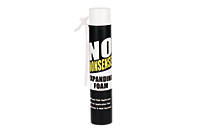
Spray foam insulation
Spray foam is a liquid chemical that expands into a foam when sprayed into position, creating air pockets that trap heat. It’s ideal for use in hard-to-reach areas or awkward spaces and takes a lot less time to install than other types of insulation. Insulating large areas is a job for professionals. But you can buy expanding foam in small aerosol cans to fill draughty gaps around doors or pipes yourself.
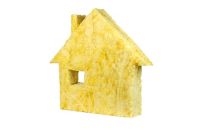
Fibreglass insulation
Fibreglass insulation is made from fine glass fibres and comes in rolls or batts (thick slabs). The insulation works by trapping heat in air pockets. It’s cheap to buy and can be installed by a DIYer, which keeps installation costs down. It can be used between rafters and joists in floors and walls but must be cut to fit the space exactly, and it must be sealed. Incorrectly installed fibreglass insulation can lose up to 50% of its effectiveness.
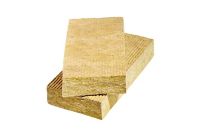
Mineral wool insulation
Mineral wool (also known as rock wool or stone wool) is made from materials such as stone and glass. The materials are heated and spun to form a fibre that acts like wool, trapping heat in air pockets. Mineral wool insulation comes in rolls or batts and is mainly used in lofts. It insulates well but must be kept dry otherwise, it loses its ability to insulate.
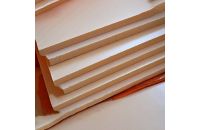
Rigid foam insulation
Rigid foam insulation is made from foam products such as polyurethane, polystyrene or polyiso. They’re also known as high-density foam boards or blown fibre boards. Rigid foam insulation can be used anywhere insulation is needed. It’s thinner than other types of insulation, so it takes up less space but tends to cost more.
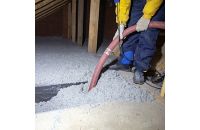
Loose-fill insulation
Loose-fill insulation is a lightweight material made from cork granules or cellulose materials (i.e., plant fibres and recycled materials like newspaper). This makes it an environmentally friendly option. It’s most often used as a top-up to existing insulation or between irregularly spaced joists where rolls of insulation don’t fit.
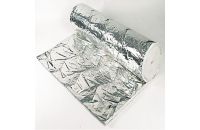
Double reflective foil insulation
Double reflective foil insulation comes in rolls and consists of an aluminium sheet with bubbles in the centre that trap heat. It’s a thin insulation material that can be used on walls, roofs or floors where there isn’t enough room for other, thicker types of insulation. In addition, reflective aluminium reduces the risk of condensation.
Other types of insulation materials
One of the less commonly used insulation materials is polystyrene. It’s 50% more effective than mineral or glass wool and is mainly used for floor insulation. There are also many insulating materials that are better for the environment due to their sustainability and/or compost-ability after use. The materials include cotton (made from recycled jeans), cellulose (made from plant fibres and recycled materials), sheep’s wool, therma-cork (made from tree bark), wood wool, hemp and papier-mache.
Types of Home Insulation
This section shows you how to improve a home's insulation by covering all the areas where insulation can be installed.
Loft Insulation
Loft insulation creates a barrier between the top floor of a house and the roof space, stopping heat from escaping.
There are two ways to insulate a loft:
Insulate the floor by laying insulation between the joists.
- This creates a cold loft space
- Use any type of loft insulation material such as rolls of mineral wool or fibreglass loft insulation
- The recommended insulation thickness is 270mm
- Existing insulation that’s thinner than 270mm can be topped up rather than starting from scratch.
Insulate the ceiling by laying loft insulation between rafters.
- This creates a warm loft space
- Use spray foam, rigid foam insulation or double reflective foil insulation
Watch our video to see how easy it is to install YBS double reflective foil insulation.
https://www.youtube.com/watch?v=yGNkec9Gzto
Loft Insulation Dos & Don’ts
Do:
- Always insulate the loft floor
- Insulate the loft ceiling if the space will be used as living space or to store temperature-sensitive items
- Lay the floor insulation to the maximum recommended thickness.
Don’t:
- Squash insulation if you place floorboards on top (this will reduce its effectiveness). You also need a 50mm clearance between the insulation and loft board to prevent condensation
- Cover any ventilation holes in the roof.
Roof Insulation
As explained in the loft insulation section, a roof can be insulated from the inside to create a warm roof. However, it can also be insulated from the outside.
Insulating a pitched roof from the outside:
- Lay insulation between rafters, underneath the roofing felt, bitumen and roof tiles
- Roof insulation types include rigid foam boards or double reflective foil insulation
- This method involves removing the roof tiles, etc., so it’s best done as part of a new roofing project.
Insulating a flat roof:
- A flat roof should be insulated from above
- Use rigid foam board or double reflective foil insulation
- The insulation is added on top of the roof’s weatherproof layer on top of the timber roof surface with a new weatherproof layer on top
Best done when the roof needs replacing anyway.
Floor Insulation
Floor insulation is designed to insulate floors at ground level. Upper floors don’t need to be insulated unless the room is underneath an unheated space such as a garage.
Floor insulation is required in older homes with suspended timber floors or solid concrete floors.
Suspended timber floors:
- Install insulation from underneath if possible (i.e., via a cellar or basement)
- Add insulation between floor joists
- Use rigid insulation boards or rolls of insulation made from any material
- If installing from underneath, secure the insulation with netting or staple it to the floor.
Solid concrete floors:
- Lay insulation on top of the floor
- Use rigid insulation boards of any material or double reflective foil insulation
- Cover the insulation with chipboard and the desired floor covering.
Other ways to insulate a floor:
- Lay underlay beneath carpets
- Apply sealant around skirting boards
- Add rugs
When considering floor insulation, weigh up the cost and potential savings versus the disruption. Floor insulation can save around £35-85 per year on energy bills. But it can be an expensive and disruptive job. The existing floor will need to be removed, and a raised floor will mean skirting boards and doors will need to be trimmed. So, it may be a job best combined with a complete room renovation.
Floor Insulation Grants
Homeowners with suspended timber floors may be able to get help with the cost of insulation through their energy supplier thanks to the government’s Energy Company Obligation Scheme (ECO). Check with your energy supplier to see if you’re eligible.
Wall Insulation
Wall insulation works by creating a barrier around the walls of a home to stop heat from escaping. The type of insulation needed will depend on the wall type.
Cavity Wall Insulation
- A cavity wall has a gap between the outside wall and the inside wall
- Applies to most homes built since 1920
- Use spray foam insulation to fill the cavity
- It’s a job for a professional installer
- It’s not suitable for homes with damp problems or walls exposed to driving rain.
Solid Wall Insulation
- Applies to most homes built before 1920
- Insulation can be installed on the inside or outside of the wall
- External insulation needs to be 50-100mm thick
- Internal insulation includes building a stud wall to which the insulation can be added
- Use rigid foam boards, fibreglass or mineral wool insulation, double reflective heat insulation or spray foam insulation
- Insulation will need to be covered with a final decorative layer
- Internal wall insulation is very disruptive as switches, skirting boards, architrave, and radiators need to be removed and replaced. It also decreases the floor space.
Other Ways to Insulate The Home
Replacing single glazed windows with double-glazing will also significantly impact a home's warmth and energy efficiency. But there are also plenty of more minor, inexpensive fixes that will help, such as:
- Hot water cylinder insulation jacket
- Cold water tank insulation
- Pipe insulation
- Insulated loft hatch (can insulate yourself or buy pre-insulated)
- Draught excluder around doors and windows
- Door brush strip
- Keyhole covers
- Letterbox plates
- Chimney pot caps (for disused chimneys)
It’s also worth considering insulating other areas in the home, such as a garage, shed or conservatory.
The cost of home insulation will vary depending on the size of a home, the type of insulation used and whether it’s installed professionally or completed as a DIY job.
But as a guide, here’s what you can expect to pay:
|
Type of insulation |
Typical costs |
|---|---|
|
Loft (all new insulation) |
£285 - £395 |
|
Loft (top up from 120mm to 270mm) |
£230 - £290 |
|
Cavity wall |
£390 - £610 |
|
Internal solid wall |
£10,000 |
|
External solid wall |
£8200 |
|
Floor |
£520 - £1300 |
Some energy suppliers offer free home insulation as part of the government's Energy Company Obligation Scheme. The scheme is open to homeowners or people living in privately rented properties who receive state benefits.
Suppliers choose which insulation they offer, but it can include loft insulation, cavity and solid wall insulation and timber floor insulation.
To check whether you’re eligible, contact your energy supplier.
Insulation Tools and Equipment
If you’re installing insulation as a DIY job, you may need some tools and equipment. Begin with your basic protective clothing and equipment such as a boiler suit, face/dust mask, protective gloves and goggles. Then prepare for insulation installation with tools such as :
-
Insulation netting
-
Insulation foam or draught excluder
-
Craft knife
-
Panel saw
-
Staple gun
-
Loft storage stilts
-
Duct tape
5 Considerations When Getting Home Insulation
It’s always important to do your research before buying and installing insulation to ensure you’re getting the right insulation for the property and situation.
Here are five things to consider:
1. Property type
If insulation is being installed into a new build, you must ensure it complies with building regulations, which are more stringent than for older homes.
You'll also have more flexibility regarding the type and method of insulation because it can be installed before roofs, walls and floors are finished. So, for example, it will be easier to install insulation on the outside of a roof than it would in an older home. Or you could use rigid foam boards for cavity wall insulation instead of foam spray because they can be installed before the plasterboard is fixed in place.
2. How energy-efficient the home is currently
When looking for the best ways to make a home more energy-efficient, consider any insulation that's already installed. Then think about what changes you can make. Weigh up the cost of buying and installing a particular type of insulation against the potential energy savings and the amount of disruption the installation will cause.
For example, topping up the thickness of loft insulation or taking simple draught-proofing measures is a relatively cheap and easy job to do that will give instant savings on energy bills.
3. Ventilation
Insulating a home is all about making it airtight. However, a house needs air to flow in and out of it to keep it fresh and avoid damp caused by condensation.
So, when installing insulation, ensure that existing grilles, airbricks, and vents aren't covered over. This is vital in areas with open fires or flues or in steamy rooms such as bathrooms and kitchens.
4. Planning permission
In most cases, planning permission isn’t required to install insulation. However, if the property is a listed building or is in a conservation area, planning permission may be needed for external wall insulation. Always check with the local authority to see if building regulations apply.
5. Safety measures
-
Wear appropriate clothing – insulation can irritate the skin, so keep your body completely covered and wear gloves
-
Wear a dust mask and goggles and keep the room well ventilated – cutting insulation causes dust to escape into the air, which can be breathed in or enter the eyes
-
Minimise dust generation – cut insulation with hand tools rather than power tools and frequently wipe the dust away with a damp cloth. Throw scraps of waste insulation into a bin bag as you work
-
Keep the work area clean and tidy to prevent tripping over.
